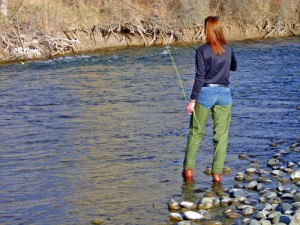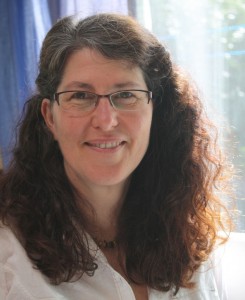Your cart is currently empty!
“FLY FISHING” writing technique with Susan Pieters!
I’m no angler… and I’m not sure whether Susan Pieters knows how to fly fish or not—but she’s a gifted writer who uses fly fishing technique in at least one of the tales she tells. Let me show you how…
In fly fishing, the lure itself is light, made to appear to be a fly or some other invertebrate. The way the fly even reaches its target is not because of the weight of the lure; it’s because of the weight of the line. The line used is usually coated with plastic to help it carry the bait farther.
In “Glass Curtain,” one of Sue Pieters’ works originally published in the Surrey International Writers’ Conference anthology of winners in 2008, the narrator is pulled between two different environments, just as a fly is snapped between air and water during casting.
On the one hand, she’s a woman experiencing mid-life crisis, clearly not satisfied with the life she finds herself living. Her husband is very practical and straight-laced, but she dreams of more; she dreams of the life her neighbour has:
“The grass is not just greener, but brighter and happier in the neighbour’s yard. As I watch Sally putting out chairs, my husband stands closer to me. I tell him she’s turning fifty, and he grunts in surprise. From here, Sally looks much younger.”
Later, commenting on her own appearance, the narrator mentions her distaste for mirrors in department stores, saying “Up so close, they make me look fat.” Her husband replies, “Mirrors are mirrors….They can only distort if they’re bent.”
It’s not exactly the reply she was looking for. “You mean that’s really how I look?”
She doesn’t want to settle for frumpy housewife of three, so in order to reach for that other world, she reaches back to another time: “… as I slide all my hangers aside, I see a black dress that I used to wear before having kids…after I find a tighter bra and stand up straight, it’s not bad.”
All along, her husband is portrayed as the practical soul who wants her to cover up that black dress with a shawl because she might get a chill, isn’t sure about the kids seeing a PG movie, and is concerned his wife might drink too much or stay out too late while he’s at home babysitting the kids next door.
The man she dreams of is more adventurous, like the James Bond with striking blue eyes in Casino Royale, a movie she’s recently viewed. At Sally’s birthday party, she meets him, a “tall Englishman, who has taken off his sunglasses. After one look, I want to tell him that he should never wear sunglasses. His eyes are the bright blue of a summer sky, clear and cloudless.”
And just like that, she finds herself drawn to a mysterious stranger who lives in the “other world,” a world she wants to be a part of.
He has an English accent and is a world traveler; for the narrator, this trip next door for a birthday party is about as adventurous as it gets.
He knows how to cook, and having forgotten to bring food for the party, goes into the backyard, slashes away at some rhubarb and bakes a delicious Rhubarb crumble on the spot. She sneaks back to her house and grabs a gallon of vanilla ice cream out of the freezer, almost getting ambushed by her kids for it in the process.
The gift he has brought with him is a painting, one he may have done himself, but in the narrator’s home, “the print hanging above the couch is crooked, my son must have knocked it with his arms. There used to be a second picture hanging above the couch as well, but he broke the glass cover on it while doing a somersault.”
He is a gifted architect, with a heritage house. Her own house “needs painting. And what would Thomas think of my own drywall problems, namely the white chalk-chunks still scattered on the carpet after my son launched a wooden sword down the stairs last month?”
All along, Pieters successfully tempts her narrator with this new man and the possibility of a new life (or some torrid affair perhaps), only to pluck her back to the reality of housework and kids and things that need to get done. She teases the reader, showing a sophisticated, cultured man who is clearly interested in the narrator, but a narrator who is hesitant to pursue him fully.
In the end, we see a woman who has enjoyed, for a short time, the attention given by someone living a life she dreams of. Her exposure to his world, even for the brief duration of the party, has changed her, and now, when she looks in the mirror, she sees something different:
“The woman before me has raindrops glistening in her dark hair, making it curl. Her eyes are attentive and curious. Her mouth has a lopsided quirk when she smiles. I know when she speaks that the most unlikely thoughts will spill out. Beneath her vest are generous and welcoming curves, asking to be held. I reach up and pull the sprig of clematis from her hair, and her smile turns wistful. She is beautiful. I have never seen her before. I am looking at myself through different eyes, through brilliant blue eyes.”
Jerked back and forth between the reality she lives daily and the life she seeks in her dream world, she finds herself settled on a blue stream, enjoying the moment. She is not a fisherwoman; she is not the prize waiting to be caught. Instead, she can drift along peacefully now, tugged neither by the expectations of her fisher family or into the waiting mouth of her “trout” Thomas. She can just be herself, the lure, as alluring as she once felt—only made aware again of that beauty’s presence by the attentions of another.
All in all, Sue Pieters plays this back and forth bit of juxtaposition skillfully throughout the entire piece, fishing for her readers, tempting them to come closer… though when they’re hooked, ultimately, they’ll be smiling–because of the weight of the lines that Pieters writes!
Comments
2 responses to ““FLY FISHING” writing technique with Susan Pieters!”
Ace, I don’t fly fish, but I do open sea fishing, with lead-weighted lines that sink out of sight into the dark deep… I thank you for this lovely blog post, which shows sensitive insight into what I was trying to communicate. It’s always a joy to be understood! Thanks. I’m always surprised when such plain bait, unadorned, pulls up a live one.
Thanks for the great read, Susan. I’m always on the lookout for tasty treats, tiny morsels of writing technique I can offer my “school of fish”. . . . . . . . . . . . . .(not an ellipsis…bubbles!).




Leave a Reply